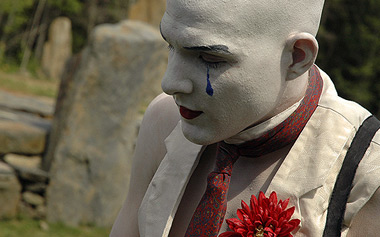The play has just ended. It was good—talented actors in a convincing production of an engaging script. It wasn’t the most hilarious, moving, stimulating or groundbreaking show you’ve seen this year, but it was solid and enjoyable, and you’re glad you came. So your applause, as the actors return to the stage for their curtain call, is vigorous and sincere.
Then, a few people a couple of rows away rise to their feet; then a few more; and then the couple in front of you stands up too, blocking your view of the stage. So you get up, and then the people behind you do, and pretty soon more than half the house is standing. The applause is steady but not seismic, and as soon as the actors head for the wings, it quickly stops and the audience heads for the exits.
This scenario, the semi-standing semi-ovation, has become the norm in recent times. Of all the curtain calls I’ve witnessed in the past year, only one received a spontaneous, full-house Standing O. A majority followed the pattern I’ve described: a few folks standing up, some more following their lead, some remaining seated, and all reaching for their coats the moment the stage lights dimmed.
That odd ritual raises some questions for this theatergoer. Do the people who jump to their feet do so at every performance they enjoy, as a matter of course? Do those who follow their cue do so from a genuine impulse, or is it peer pressure, or not wanting to seem ungrateful, or because they’d rather be looking at the actors than at someone else’s behind? Do those who doggedly keep their seats—because, dammit, the show was good but not sensational—feel like curmudgeons? And do the actors taking their bows look out at the house and figure the folks still in their seats must have hated it?
I guess what puzzles—okay, annoys—me is how perfunctory the Standing O has become. It seems it’s devolved into an almost knee-jerk response, a sign of generous approval rather than real enthusiasm. I’d love it if audiences not only jumped out of their seats but stomped and cheered after truly electrifying performances. But that, in this well-behaved though vertically-disposed theatergoing public, doesn’t happen.
Except once, this past summer, it did.
After the success of last summer’s Scaramouche Jones, Pauline Productions brought Rylan Morsbach back to the Valley to reprise his performance. It’s a one-man journey through the 20th century, told by a 100-year-old clown who has seen it all. Morsbach’s portrayal is an exhilarating tour de force by a 21-year-old who has the technical chops and emotional range of a practiced veteran.
At the end of the performance I saw at the Majestic Theater in June, the audience rose as one to greet the performer as he returned to the stage for an almost bashful bow. As he retreated to the wings the house lights came up, but the applause, the cheers and yes, the foot stomping continued. It wasn’t until Morsbach had taken four command curtain calls that the audience was finally satisfied and headed home.
Now that, ladies and gentlemen, is a Standing O.



